Are you struggling to make the money you want with your business? Profit margins are the key to measuring and improving your financial success. Did you know some industries hit 50% net profit? We’ll show you how.
The average gross margin is 38.44% across 7,229 publicly owned companies, and the average net margin is 9.84%. But if you are a service-based industry, you can try to hit over 50% net margins to make a great living.
Understanding margins will help you create a more profitable business model because you’ll be able to quickly identify where you can make improvements.
In this article, we’ll explain:
- Where to find industry profit margins
- The seven most common equations for calculating profit margins
- Calculating industry profit margins
- Improving your business results by comparing your profit margin ratio to industry averages
What profit margins should you expect?
You’ll need industry benchmarks before you can possibly know whether your profit margins are high, low, or average. At UpFlip, we have access to three data sets we use regularly:
- IBIS World: Here’s their list of highest margin businesses. Their paid reports are phenomenal and are what is used in most blogs to help you get an idea of what your expenses should look like.
- NYU STERN: Analyzes 7,229 publicly owned businesses and publishes 17 different margins and percentages of revenue for each. They update the documents annually.
- UpFlip Featured Businesses: Our YouTube Channel and blog are full of business owners sharing how they run their businesses and where their costs go.
You’ll find great benchmarks that will help you establish how your margins are.
What is the profit margin?
Profit margins measure the difference between business expenses and revenue as a percent of the revenue. There are eight types of profit margins you may want to monitor:
- Gross profit margin
- Net profit margin
- Operating profit margin
- EBIT margin
- EBITDA margin
- Product margin
- Sales margin
We’ll look at each of the profit margins and how you can better use them to manage your small business.
What is gross profit margin?
Gross profit is the difference between gross sales and the cost of goods sold (COGS). The cost of goods sold includes all raw materials, labor, and shipping that are incurred directly from the goods sold.
The gross profit margin is gross profit divided by the revenue. You may also hear it referred to as gross margin.
The gross profit margin formula is included in the following picture. I have also provided an example of how to calculate the gross profit margin:

Many service businesses use the gross profit margin to help employees create quick estimates. With a gross margin of 50%, they can simply add the cost of their hours and the cost of the parts then multiply by 2 to get the quote price.
Why are restaurant profit margins so low?
This might be shocking to hear, but the average profit margin for the restaurant industry isn’t as low as you would think. Based on 70 publicly held companies, restaurants have average profit margins of 31.52%, operating margins of 15% to 18%, and a net profit margin of 12.63%.
A restaurant with a low-profit margin needs to review its pricing strategies, increase its revenue, or reduce its costs.
Let’s look at net profit margins next.
What is net profit margin?
Net profit margin is probably the most common type of profit margin people will be interested in. Net profit is how much money the business made after all expenses including:
- Cost of Goods Sold
- Administrative and Marketing
- Depreciation
- Amortization
- Interest
- Taxes
You may also hear this called the net profit margin ratio or net profit ratio. The net profit margin equation and an example of how to calculate the percentage is shown below:

This is what you hear companies report in the earnings reports and is the amount that would qualify as income to a small business owner who does not pay themselves a salary.
Is a profit margin of 20% good?
A 20% net profit margin is good in most industries, but in some industries, that profit margin is low, while in others, a good margin would be over 30% to 35%. If you’re asking about gross profit margin, 20% is a horrible margin for most industries. As a general rule, the cost of sales should be less than 60% of net sales.
Let’s look at the operating profit margin next.
What is operating profit margin?
Operating profit margin is measured as a percentage of operating income. The operating margin includes all income and expenses from operations but excludes:
- Interest income or interest expenses
- Returns and costs from investment in other companies
- Taxes
- One-time costs or gains like lawsuits
You’ll want to take the gross income and subtract the following operating expenses to find the operating income:
- Costs of Sales, General, and Administration (SG&A)
- Overhead Costs (OC)
- Depreciation (Dep) (how much your equipment and buildings go down in value based on their expected life)
- Amortization (Am) (lowering the book value of a non-physical asset)
The operating profit margin may also be called the operating income margin or operating margin. To calculate the profit margin for operations, use the formula below. I’ve also included an example of operating profit calculations:
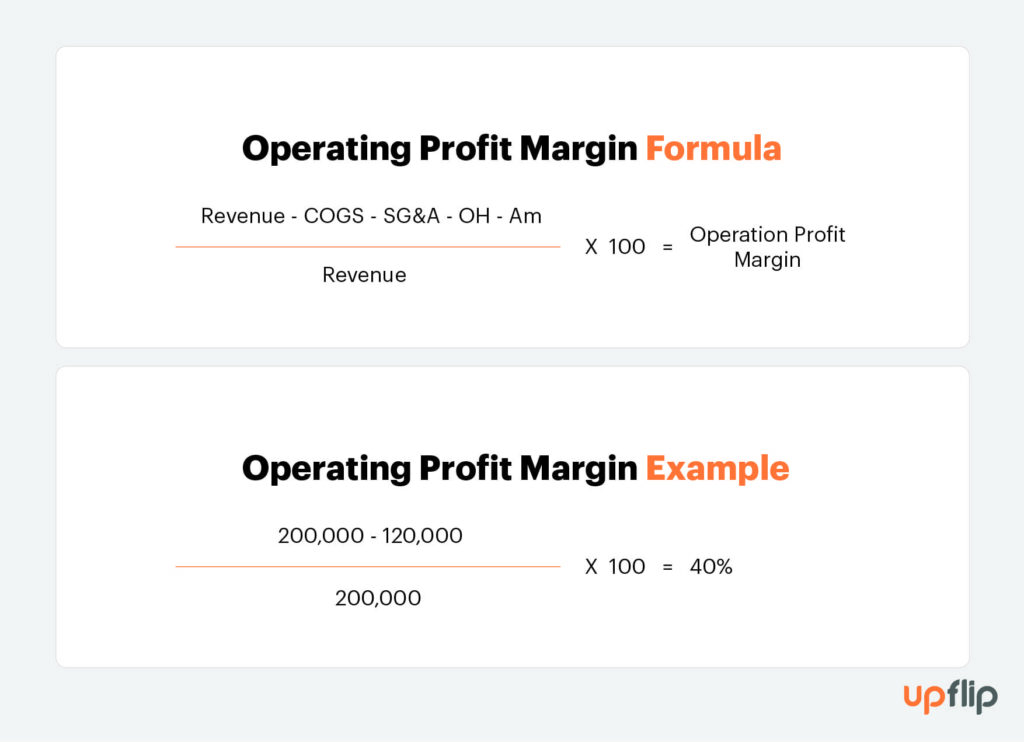
The operating profit margin is useful because it helps businesses establish how well they are doing operationally. These can be used to compare different divisions of a company.
If your operating profit is negative, then you will either need to increase revenue or decrease operating expenses––if not, it will create cash flow challenges.
If you have interest income or dividends from another business, you will probably want to compare the operating margin with the EBIT margin. Let’s look at that measure of a company’s profitability next.
What is EBIT margin?
EBIT stands for “earnings before interest and tax expenses.” This will normally be similar to operating profit margins, but for companies with earnings from investments, you will want to compare the two.
For instance, in some quarters, a large portion of Tesla’s profitability has been impacted by the price of Bitcoin. Comparing the operating profit margin and the EBIT profit margin would help you identify what profitability is from the company’s revenue and which is from investments.
To find the EBIT, just find the net profit and add the interest and taxes to the net profit. Then divide by revenue.
The equation shows how to calculate the EBIT margin with an example:
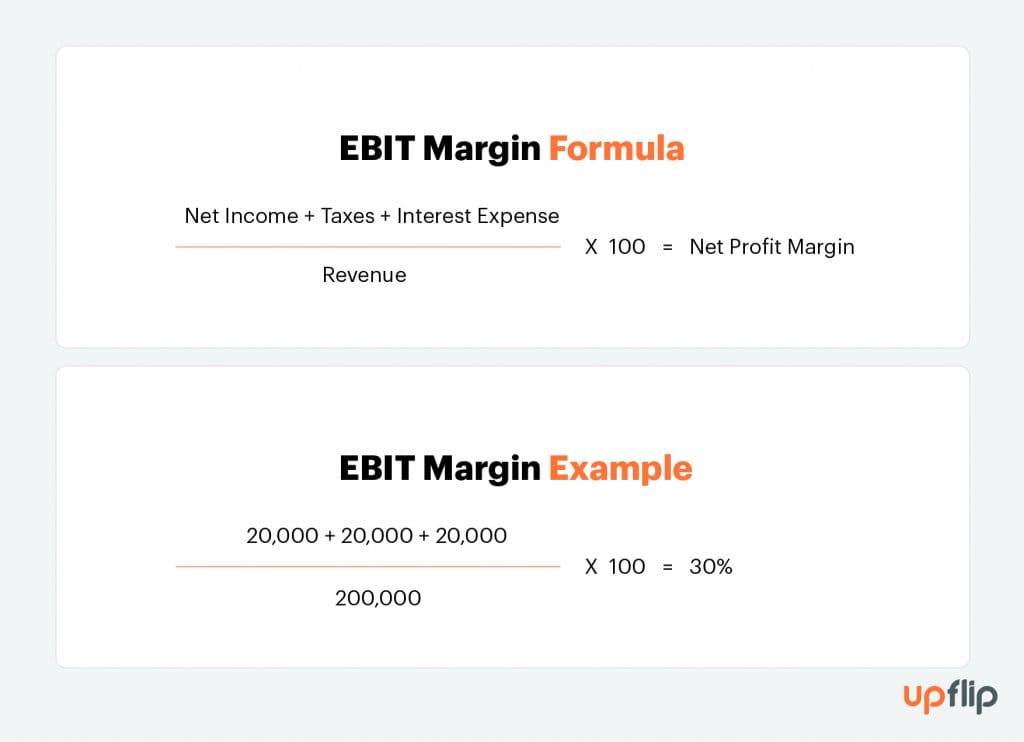
I intentionally made this one where I could show you an absurd example of what could happen when comparing EBIT and Operating margins. As you can see from the two examples, the company lost 10% of its revenue from investment losses or a lawsuit.
Another margin that can help business owners is EBITDA, which we’ll discuss next.
What is EBITDA?
EBITDA refers to “earnings before interest, taxes, depreciation, and amortization,” which is a way of separating the company debt from the profit margin calculation. This is especially beneficial if you want to buy a company with debt.
To find this ratio, you’ll add the depreciation, amortization, interest, and taxes to the net income. You can see how to calculate the EBITDA margin equation below:
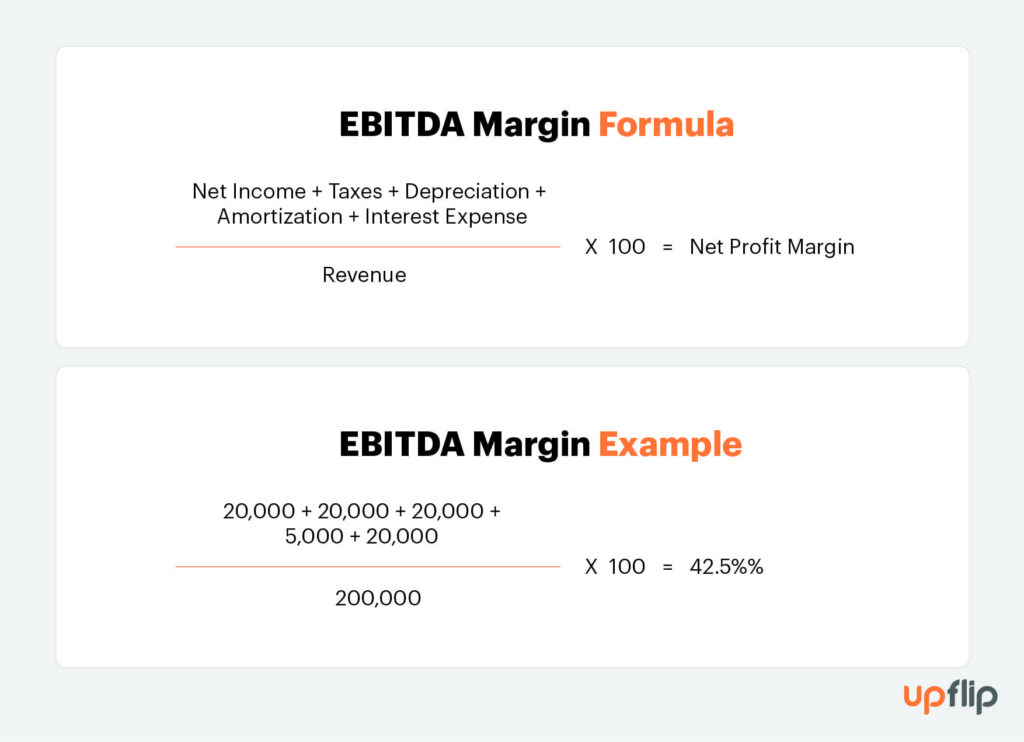
I’ve been using the same numbers throughout to make the profits really easy to compare. As you can see, there is a lot of depreciation. I would not expect depreciation to be this high of a percentage unless the company is in the early stages and bought a factory to produce their products.
Speaking of products, let’s look at the product margin.
What is product margin?
Product margin is the profits on an individual product divided by the sales price. This is helpful for comparing product lines to determine:
- Which new products should a business carry?
- What products are best for upselling?
- Should you consider getting rid of an offering?
This does not calculate the actual profits, but it lets you know how much of the sales price can go to other costs. Use the equation below to calculate product margins:
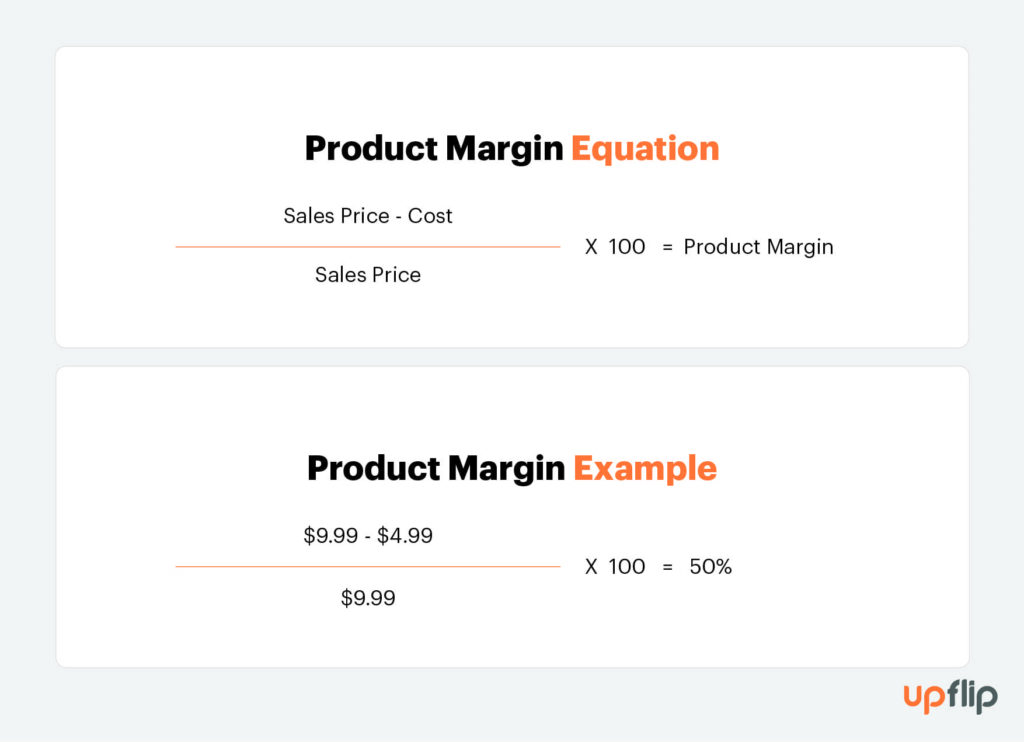
What is sales margin?
The sales margin is similar to the gross profit margin, but it is calculated on a per product basis. It includes not only the cost of the product but other expenses like marketing costs and labor associated with achieving the sale.
It may also be called the contribution margin, which we discuss in detail in our blog about calculating a business break-even point. The following formula is used to calculate the profit from each sale:
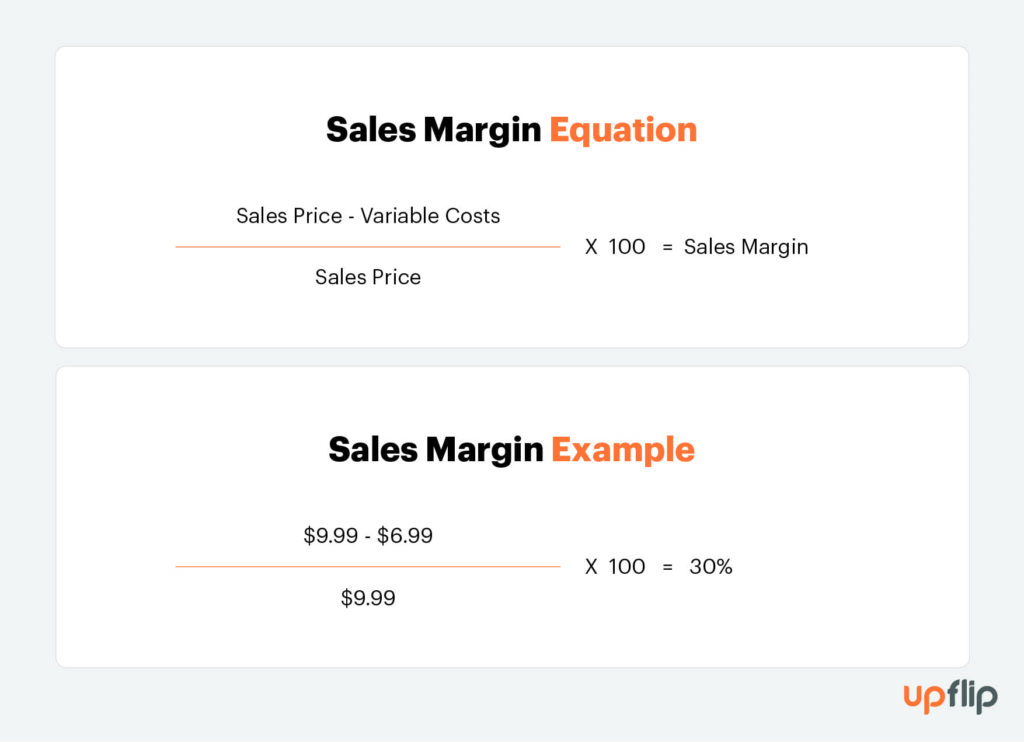
Ultimately, this equation shows how much increasing sales will increase your profitability. It will also show how many products you need to sell to cover your costs.
Next, let’s compare the net profit margin and the gross margin.
Net Profit vs Gross Profit
The two most commonly used profit margins are the net profit margin and the gross profit margin. Both of these matter to the performance of a company.
The gross profit margin is revenue minus the cost of goods sold divided by total revenue. As long as this is a positive number, then you can theoretically continue to justify running the business. There’s a catch though.
If gross profit isn’t high enough to cover the additional costs that are included in net profit plus your living expenses, you’ll need another source of income to keep the business running.
Meanwhile, the net profit margin is what most business owners will be focused on because it’s the amount they take home as profits for running the business. The higher it is, the easier it will be to grow the business. It’s just total revenue minus total expenses divided by total revenue.
How to calculate profit margins
I’ve explained how to find profit margins in each section but the general process is:
- Find the revenue attributable to the type of profit margin.
- Calculate the expenses attributable to the profit margin.
- Use the formula in the picture below:

You might want to use a net profit margin calculator to help you with pricing your products and setting up automations to help you manage your finances more effectively. I use an Excel Sheet to calculate various margins when needed, but you can find online calculators, too. Of the online profit calculators, the Calculator Site is the most well made.
What are good profit margins?
A good profit margin will depend on your industry, but most industries will have the following ratios:
- Gross Margin: 38.44% is average, but the range is from 1.41% for air transport to nearly 100% for money centers.
- Net Margin: 9.84% is average, but it ranges from a high of 32.61% for money centers to a low profit margin of -28.57% for hotel and gaming. The gaming losses were due to light travel and shutdowns during the pandemic.
- Operating Margin: 10% to 14% is the average, depending on whether you want to include stock payments and taxes in the numbers. Like other margins, the range varies from -23% to as high as 45% operating margins.
This information was gathered from NYU Sterns, which regularly analyzes the income statements of more than 7,000 companies to analyze financial ratios. The site shows the net margin, gross margin, and 15 other ratios to help you understand how publicly held companies in each industry perform.
Make sure you compare your pricing strategies and company’s profits to the same industry to make sure you aren’t making pricing errors that will prevent you from generating profits.
Next, we’ll discuss how understanding the different types of profit can help you improve your company’s profit.
How can you improve profit margins?
Large businesses weren’t always as big as they currently are. Like every business, they normally start with no revenue. As the company grows, it finds new ways:
- Increase the revenue.
- Decrease the total expenses as a percentage of revenue.
- Make more net income, a byproduct of the first two.
Let’s look at how to increase company revenue first.
Increase Revenue

Finding ways to increase revenue can be challenging, but a net income statement can help you identify areas where you might be able to increase revenue.
Some areas you may want to look at to improve profit through revenue increases include:
- SG&A or Advertising Budgets: If your marketing percentage is less than the industry average, you may have an opportunity to increase your sales revenue through marketing. A higher SG&A is a sign of inefficiencies in your processes.
- Product and Sales Margins: Set your product margins to be in line with the gross profit margin of the industry and then compare them to your current prices.
- High Current Price: Consider lowering it to meet the industry average margins. It might stimulate sales.
- Low Current Price: Increase the profit margin to where you make more money per product.
- Labor Cost Percentage: If the labor cost percentage is really low, you may need to hire more people to provide a better service and create more revenue. If you aren’t working at capacity, you may want to add new products or services also.
- Sales Returns: If you experience lots of sales returns, you may want to figure out why. It will improve your efficiency and lead to more profit because returns still cost you money from transaction fees.
These are just some ways to increase your total sales. Now, let’s look at ways to lower your expenses.
Reduce Expenses
If your total sales are where you want them, but your cost of doing business is high, this will cause the company’s net income to be lower than you’d like. You’ll need to review your net income statement, which will look something like this:
| Gross Sales | $1,000,000.00 | 100.00% |
| Less: Sales Returns and Allowances | $200,000.00 | 20.00% |
| Less: Cost of Goods Sold | $300,000.00 | 30.00% |
| Less: Direct Costs (Labor, Shipping, Etc.) | $100,000.00 | 10.00% |
| Gross Profit | $400,000.00 | 40.00% |
| Expenses | 0.00% | |
| Less: Rent | $60,000.00 | 6.00% |
| Less: Utilities | $60,000.00 | 6.00% |
| Less: Other Wages | $80,000.00 | 8.00% |
| Less: Commissions | $10,000.00 | 1.00% |
| Less: Supplies | $5,000.00 | 0.50% |
| Less: Marketing | $80,000.00 | 8.00% |
| Less: Logistics | $20,000.00 | 2.00% |
| Less: Repairs and Maintenance | $20,000.00 | 2.00% |
| Less: Miscellaneous | $5,000.00 | 0.50% |
| Operational Profit | $40,000.00 | 4.00% |
| Less: One Time Costs (lawsuits, purchase competitor, etc) | $0.00 | 0.00% |
| Other Income (dividends, interest income) | $20,000.00 | 2.00% |
| EBITDA | $80,000.00 | 8.00% |
| Less: Depreciation | $10,000.00 | 1.00% |
| Less: Amortization | $10,000.00 | 1.00% |
| EBIT | $60,000.00 | 6.00% |
| Less: Interest | $10,000.00 | 1.00% |
| Earnings Before Tax | $50,000.00 | 5.00% |
| Taxes (Assume 21% Corporate) | $10,500.00 | 1.05% |
| Net Income (Loss) | $39,500.00 | 3.95% |
You’ll want to look for areas that are really high. In this scenario, you would want to find ways to reduce the returns, cost of goods sold, rent, and utilities.
Let’s look at how dropping these expenses to the level of similar businesses would impact your net profit margin ratio.
- Returns: Shopify estimates that returns are typically 10.6% of purchases. This reduction would increase gross income and net income to better than average percentages and make the business nearly $75K more after-tax profit. You’d need to find patterns that are causing returns and figure out how to correct them.
- COGS: Reducing the material costs to 20%, which is a common recommendation for restaurants, would create a similar change as the returns. This would require finding lower-cost but comparable-quality vendors.
- Rent & Utilities: Using the final column of the NYU Sterns sheet, you can see that most industries would have 1.62% of their revenue dollar going to the lease. If you use that number for utilities too, it would increase the profit by nearly $70,000.
Combine all these changes, and you would turn $39,500 net income into over $261,000 which would be likely to attract investors in almost any industry.
Improve your profit margins for greater business success
At this point, we’ve answered the following questions:
- What are profit margins?
- How to find profit margin using the profit margin equation?
- What is a good profit margin?
- How do you find products with high-profit margins using the product and sales margin?
- How can I decrease sales expenses?
- How to improve net sales with an income statement comparison?
Now it’s up to you. Follow business news. Track your data. Look for seasonal patterns. Improve the profitability of your services.
What strategies have you used to impact your gross and net sales? Which succeeded and which failed?




